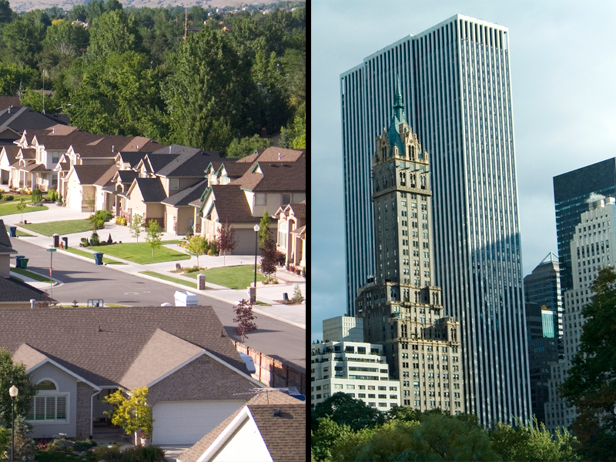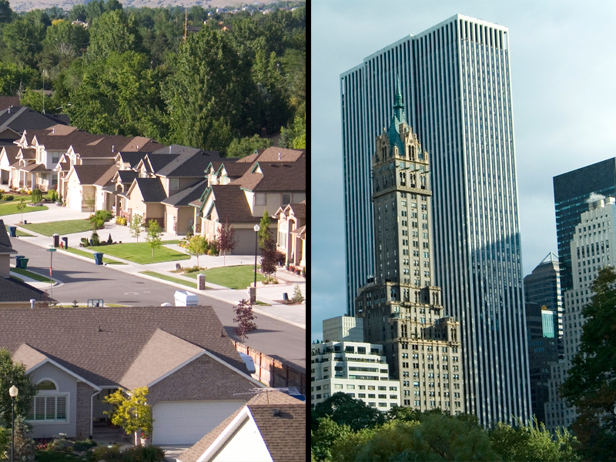 Alex Steffen—futurist, Worldchanging editor, tall person—makes the provocative argument that there’s really no way to make outer-ring suburbs sustainable. He thinks cities vs. suburbs is the political conflict that will define the next decade, a fact that climate-focused groups have been slow to acknowledge. The real potential, he suggests, lies with urban dwellers who don’t identify as activists or environmentalists–people working in architecture, design, planning, community development, housing, building, local energy, local food, alternative transportation, and the like.
Alex Steffen—futurist, Worldchanging editor, tall person—makes the provocative argument that there’s really no way to make outer-ring suburbs sustainable. He thinks cities vs. suburbs is the political conflict that will define the next decade, a fact that climate-focused groups have been slow to acknowledge. The real potential, he suggests, lies with urban dwellers who don’t identify as activists or environmentalists–people working in architecture, design, planning, community development, housing, building, local energy, local food, alternative transportation, and the like.
Some of this is in my piece on activism after Copenhagen. Here’s more:
Q. Where do the suburbs fit into the urban focus you’re calling for?
A. The biggest fight I think we’ll see in the next ten years is the fight between people in cities who are trying to transform them into ‘bright green’ cities and those economic interests in the [outer-ring] suburbs who see that as a threat to their livelihoods, and in some cases just despise it on ideological grounds.
Q. Are you saying the suburbs are hopeless?
A. “Suburbs” is a clumsy word because it can mean a lot of different things. One essential set of suburban interests are wealthier outer-ring suburbs, sprawl developers, highway builders, the auto industry, and oil companies. They are all in cahoots and have been for a long time. They’re a big part of the U.S. economy that is about building sprawl on the fringe. And they are pretty clear about their opposition to reinvesting in cities to and to fighting auto dependence.
If the big [environmental] groups really wanted to do something effective, they should start a bunch of campaigns helping inner-ring suburbs identify themselves as urban places, places that have a lot more in common with central cities than with outer-ring suburbs. That’s where the future of the environmental movement is going to be fought.
Q. What’s keeping green groups from doing this?
A. I think they don’t want to portray sustainability as something that is in juxtaposition to sprawling, auto-dependent lifestyles. There’s a sense of, “We don’t want to be in a war with the suburbs.” But I think the war is here, I think it’s at our door. And we didn’t start it.
We are in a situation where we have an opposition party, essentially running the U.S. government, that is willing to say things like, “Climate change is a hoax.” It represents a minority of Americans. It’s completely beholden to big business and is very clearly using xenophobia, racism, and fear of change to block environmental, climate, transportation, and energy action. Basically, they are making this about, ‘Do you really want urban people destroying your way of life?’
The idea that this is not already a fundamental conflict and that we can somehow squeak this by the suburbs is foolish. It’s a false hope.
Q. So there’s no point trying to show outer-ring suburbanites this future is in their interest?
A. One of the real problems is that we’ve spent the last ten years trying to convince that group that there is a vision of this future that is going feel to feel OK to them. I’m no longer convinced that there’s a vision of the future that will ever feel OK to them.
But there are so many more winners than losers in this fight that it’s a smart fight to take on. We are becoming an urban planet. We are already an urban country. When you add together cities and inner-ring suburbs and allied small towns, it’s a solid majority of Americans.
Q. What do you do with the fact that so much electricity and fuel comes from outside cities?
A. There’s a real tendency on the part of some climate activists to think in terms of what I call “the swap,” which is to assume that we need to keep the particular assemblage of technologies and land-use patterns that have made up suburban American life so far. Things like single-family homes in low-density developments, places that have no street grid, places that are income-segregated, the idea of bedroom communities, homes that are poorly insulated, products that are poorly designed so that people buy a lot of cheap crap that breaks all the time. A lot of people just assume that’s a given and we need to figure out how to power that with renewable energy.
I question whether that is even technically possible. But even if we could do it, it’s clearly not something that we’re going to do. We really better define our goal differently. It is very possible to have lives that are just as prosperous, and nicer, that use 5 percent of the fossil fuels and virgin materials we do now. But if we’re living anything like the average McMansion-ite, SUV-driving suburbanites, there’s simply no way that can be powered in a climate-friendly way.



